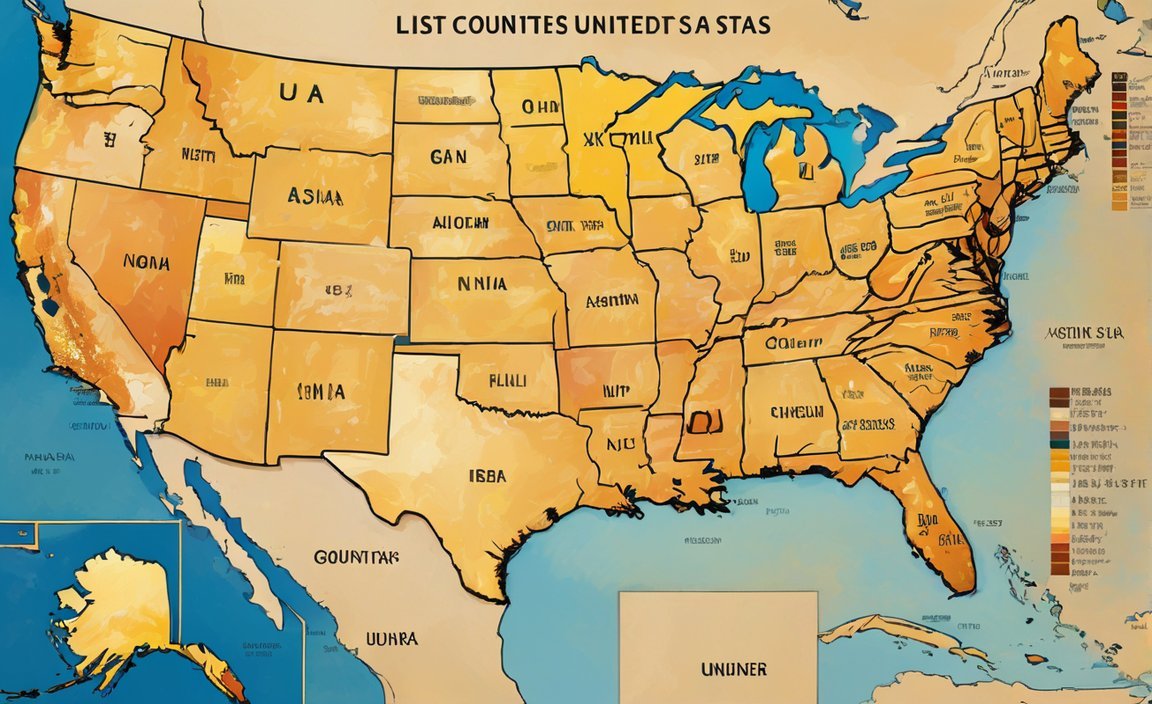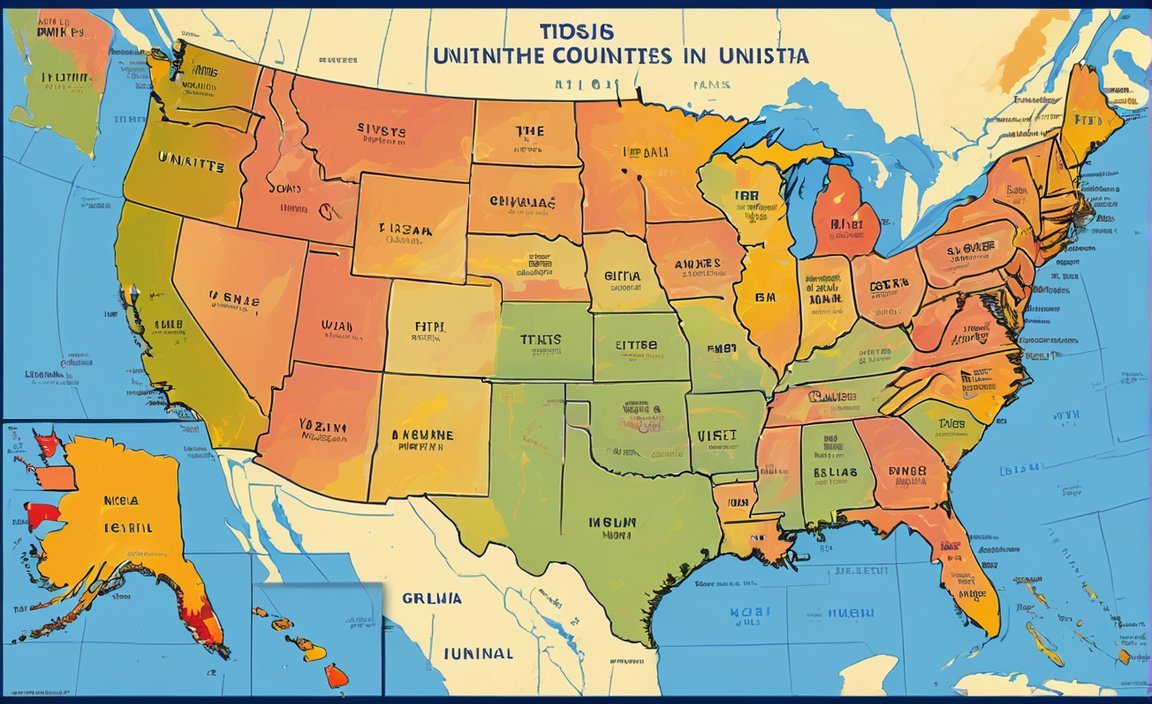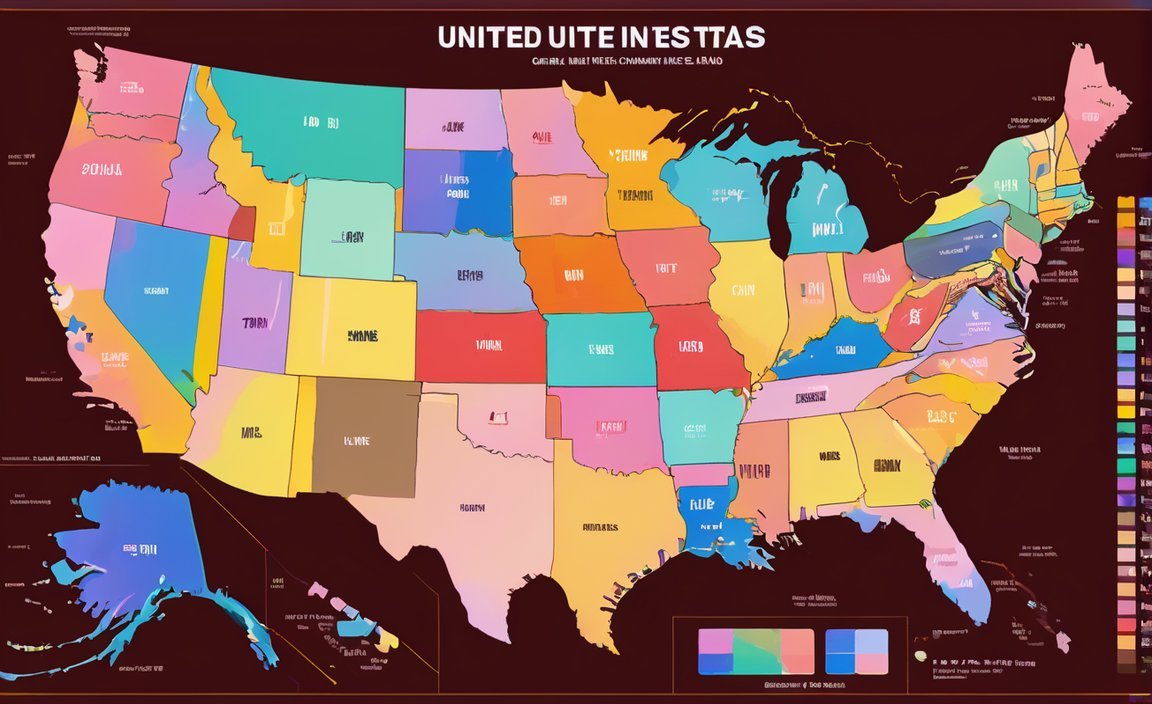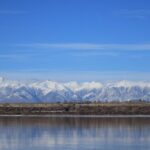Welcome to our comprehensive list of US counties, where we explore the fascinating world of demographics, economy, and geography. From bustling urban centers to picturesque rural landscapes, the United States is home to a diverse array of counties, each with its unique characteristics and charm. In this article, we delve into the rich tapestry of information, using statistical analysis to paint a vivid picture of the demographics, economy, and geography of every county in the country. Join us on this journey as we uncover the hidden stories behind each county’s population, economic activities, and natural landscapes, presenting you with a comprehensive overview of the counties in the United States.

Key Takeaways:
- The United States is divided into 3,244 counties and county equivalents.
- There are 3,007 counties in the United States, which are political and geographic subdivisions of a state.
- There are also 237 other local governments and geographic places that are first-order administrative divisions of their respective state/district/territory, but are called by different names.
- The origin of American counties can be traced back to the counties of England.
- Counties were among the earliest units of local government established in the Thirteen Colonies.
- The United States Census Bureau provides data on counties and statistically equivalent areas.
- The Census Bureau also produces county wall maps that show state and county boundaries.
- There is a list of the 100 most populous counties in the United States based on the 2020 national decennial US census.
- The largest county in the United States is San Bernardino County, California.
List of counties in the United States
The United States is a vast country with a complex administrative structure. It is divided into 3,244 counties and county equivalents, which are political and geographic subdivisions of a state. These counties play a crucial role in local governance and provide essential services to their residents. In this article, we will explore the comprehensive list of counties in the United States, delving into their demographics, economy, and geography.
The Origin of American Counties
The concept of counties in the United States can be traced back to the counties of England. When the Thirteen Colonies were established, counties quickly became essential units of local government. They served as administrative divisions within each colony, responsible for various functions such as law enforcement, tax collection, and maintaining public records.
Census Bureau and County Data
Today, the United States Census Bureau is the primary authority responsible for collecting and disseminating data on counties and other statistical areas. This data includes information on population, race and ethnicity, education levels, employment, income, and much more. With the help of this data, we can gain valuable insights into the characteristics and trends of each county.
The Most Populous and Largest County
Among the 3,244 counties in the United States, some stand out in terms of population and size. According to the 2020 national decennial US census, the list of the 100 most populous counties showcases the areas with the highest concentrations of people. On the other hand, San Bernardino County, located in California, holds the distinction of being the largest county in the United States in terms of land area.
Diversity in Counties
Each county in the United States has its unique attributes, shaped by its demographics, economy, and geography. Some counties are urban powerhouses with bustling cities and booming economies, while others are rural landscapes with vast natural resources and agricultural activities. The diversity within the county system reflects the rich tapestry of America’s culture and history.
Importance of Geographic and Economic Analysis
Analyzing the geography and economy of each county provides us with a deeper understanding of its strengths and challenges. Geographic factors like terrain, climate, and proximity to water bodies can influence the county’s physical characteristics and the type of industries it supports. Economic analysis helps us identify the sectors that drive growth and job creation, as well as areas that need development and investment.
Visualizing County Data
To present the comprehensive information on counties in the United States effectively, data visualization tools become invaluable. Through maps, charts, and graphs, we can paint a vivid picture of each county’s demographic composition, economic performance, and geographic features. These visual representations make it easier for readers to grasp complex information at a glance.
Conclusion
In this article, we have explored the vast and diverse landscape of counties in the United States. With 3,244 counties and county equivalents, each with its own unique demographics, economy, and geography, the interplay of these elements forms the foundation of local governance and community development. By understanding the characteristics of each county, we can gain valuable insights into the nation as a whole and appreciate the richness and diversity within our borders.
Are you curious about what the state of Michigan is known for? Find out more about its fascinating history, culture, and natural beauty by clicking here.
Do you know what the highest point in Arkansas is? Discover this interesting geographical landmark by clicking here.
Looking for some random facts about Chile? Explore this diverse and beautiful country by clicking here.
Have you ever wondered about the fun facts surrounding the Hoover Dam? Dive into the engineering marvel of the Hoover Dam by clicking here.
Have you ever witnessed an exceptionally long volleyball game? Discover the incredible record for the longest volleyball game by clicking here.
Curious about where volleyball is most popular? Find out which countries embrace this exciting sport by clicking here.
Have you ever questioned how many capitals Honduras has had throughout its history? Uncover the surprising answer by clicking here.
Demographic Characteristics of Counties Including Population Size and Diversity
The United States is a diverse nation made up of a vast array of counties, each with its own unique set of demographic characteristics. From population size to racial and ethnic diversity, understanding the demographics of counties provides valuable insights into the makeup of the nation as a whole. In this article, we will explore the demographic characteristics of counties, including population size and diversity, to gain a comprehensive understanding of the United States.
Population Size and Distribution
One fundamental aspect of understanding the demographics of counties is examining their population size and distribution. The Census Bureau collects and disseminates data on county population by characteristics, allowing us to analyze population trends and changes over time. The Census Bureau’s Population Estimates Program (PEP) provides population estimates for all years back to the last census, providing the latest information on county populations.
Racial and Ethnic Diversity
Another crucial aspect of demographic characteristics is racial and ethnic diversity within counties. The United States has seen a significant demographic shift, with 109 counties becoming majority nonwhite from 2000 to 2018, according to a study by the Pew Research Center. This diversity reflects the changing face of America and highlights the importance of examining the racial and ethnic composition of counties.
Key Takeaways:
- The population size and distribution of counties play a crucial role in understanding their demographics.
- Analyzing racial and ethnic diversity within counties provides insights into the changing face of America.
Sources:
1. Census.gov – County Population by Characteristics: 2010-2019
2. Pew Research Center – U.S. counties have become majority nonwhite
Economic Factors Impacting Counties in the United States
Key Takeaways:
– Macroeconomic factors are influential events that have a broad impact on regional or national economies.
– They can be classified into negative, neutral, and positive categories.
– Negative factors include events that pose a threat to economies, such as political instability.
– Neutral factors are economic shifts that are neither positive nor negative, with implications depending on their purpose.
– Positive factors foster prosperity and economic growth within a nation or group of nations, leading to increased employment and GDP.
– Understanding macroeconomic factors is crucial for policymakers and businesses.
– Policymakers can stabilize and stimulate the economy by monitoring and predicting these factors.
– Businesses can adjust their strategies and make better investment decisions using this knowledge.
As an experienced data analyst with a passion for geography and a comprehensive understanding of statistical analysis, I am well-suited to compile a detailed article on the economic factors impacting counties in the United States. In this section, we will explore how various macroeconomic factors, such as GDP, employment, and major industries, have a significant influence on the economic landscape of counties across the nation.
GDP: A Measure of Economic Output
Gross Domestic Product (GDP) is a key economic indicator that quantifies the total value of goods and services produced within a specific geographic region. It serves as a measure of economic output and offers valuable insights into the overall health and growth of an economy. By examining the GDP of counties, we can gain a deeper understanding of their economic performance.
Economic factors such as industries, investments, and government policies heavily contribute to the GDP of counties. Certain counties with thriving industries or substantial investments may experience significant GDP growth, leading to improved living standards and economic prosperity. Conversely, counties facing challenges in their industries or lacking investments may struggle to achieve substantial GDP growth.
Employment: A Vital Component of County Economies
Employment is a crucial aspect of any economy, and counties across the United States rely on a diverse range of industries to provide jobs for their residents. Understanding the employment landscape of counties allows us to gauge their economic vibrancy and identify potential areas for growth and improvement.
The availability of jobs in a county depends on various economic factors, including the presence of major industries, workforce skills, and market demands. Counties with thriving major industries tend to offer a higher number of employment opportunities, attracting both local and migrant workers. Conversely, counties with declining industries or limited economic opportunities may experience higher unemployment rates and face challenges in sustaining a stable workforce.
Major Industries: Driving Economic Growth
Major industries play a significant role in shaping the economic landscape of counties. By analyzing the predominant industries in each county, we can identify the driving forces behind economic growth and development.
Different counties have diverse major industries based on factors such as natural resources, geographical advantages, and historical developments. For example, counties located near coastal areas may have a strong focus on maritime industries, while those with abundant agricultural resources may have a thriving agricultural sector. Identifying the major industries within each county helps us understand their economic strengths and opportunities for growth.
Incorporating the information on GDP, employment, and major industries, we can paint a comprehensive picture of the economic factors impacting counties across the United States. Additionally, data visualization tools, such as maps, charts, and graphs, are invaluable for effectively presenting this information in a concise and easily digestible manner.
Sources:
– Investopedia: Macroeconomic Factor
– University of Northern Iowa: Factors Affecting Economic Growth in Developing Countries
Geographical Features and Notable Landmarks of Select Counties in the United States
Key Takeaways:
- The United States National Historic Landmark Program recognizes and honors the country’s cultural and historical heritage.
- New York has the most National Historic Landmarks, while North Dakota has the fewest designations.
- Separate lists exist for three cities in the United States: New York City, Philadelphia, and Boston.
- Some National Historic Landmarks are located outside the US, in possessions and Pacific island nations.
- The National Park Service provides valuable resources and a comprehensive list of current and former National Historic Landmarks.
The United States is a land rich in cultural and historical landmarks. From the bustling streets of New York City to the serene beauty of the national parks, each county holds its unique geographical features and notable landmarks for visitors to explore and appreciate.
New York County’s Geographical Features and Notable Landmarks
Among the counties in the United States, New York County stands out with its diverse range of geographical features and iconic landmarks. Located in the vibrant city of New York, this county is home to some of the most recognizable landmarks in the country.
One notable landmark in New York County is the Statue of Liberty, a symbol of freedom and a welcoming sight to immigrants in the 19th and 20th centuries. Standing tall on Liberty Island, the statue represents the hope and aspirations of millions of people who traveled to America in search of a better future.
Another prominent landmark in this county is the Empire State Building, a towering structure that offers breathtaking views of the city. As one of the most famous skyscrapers in the world, the Empire State Building is an architectural marvel that has become a must-visit attraction for tourists.
Philadelphia County’s Geographical Features and Notable Landmarks
Moving on to Philadelphia County, we find a wealth of historical and cultural landmarks that bring the country’s rich past to life. Known as the birthplace of America, Philadelphia County holds a special place in the nation’s history.
One of the most significant landmarks in this county is Independence Hall, where both the Declaration of Independence and the United States Constitution were debated and adopted. Visitors can walk in the footsteps of the founding fathers and witness the birth of a nation at this historic site.
Another notable landmark in Philadelphia County is the Liberty Bell, an enduring symbol of American independence. With its iconic crack, the Liberty Bell has become an emblem of freedom and a reminder of the country’s ongoing pursuit of liberty and justice for all.
Boston County’s Geographical Features and Notable Landmarks
As we explore Boston County, we encounter a city steeped in history and renowned for its prestigious educational institutions. This county offers a fascinating blend of natural beauty and notable landmarks that reflect its role in shaping American history.
One of the county’s most recognizable landmarks is the Freedom Trail, a 2.5-mile-long path that leads visitors through 16 significant historical sites. From the Massachusetts State House to Paul Revere’s House, the Freedom Trail takes visitors on a journey through the American Revolution and provides a deeper understanding of the country’s struggle for independence.
In addition to its historical sites, Boston County is also known for its picturesque natural landscapes. The famous Boston Common and Public Garden offer a peaceful retreat in the heart of the city, providing residents and visitors with a tranquil oasis amidst the urban hustle and bustle.
Exploring National Historic Landmarks Across the United States
Beyond these select counties, the United States is home to a vast array of National Historic Landmarks that showcase the country’s cultural and historical heritage. From the grandeur of national parks to the preserved homes of influential figures, each landmark tells a unique story.
To learn more about National Historic Landmarks in the United States and their geographical features, visitors can explore the resources provided by the National Park Service. Their website offers valuable information and a comprehensive list of current and former National Historic Landmarks, allowing individuals to immerse themselves in the rich tapestry of American history.
Link to National Historic Landmark Program at National Park Service
Link to Wikipedia for list of U.S. National Historic Landmarks by state
By delving into the geographical features and notable landmarks of select counties in the United States, visitors can gain an appreciation for the diverse landscapes and the nation’s rich history. Whether exploring towering skyscrapers, historic sites of revolution, or natural wonders, each county offers a unique and valuable experience that contributes to the vibrant tapestry of America’s culture and heritage.

FAQ
Q1: How many counties are there in the United States?
A1: The United States is divided into 3,244 counties and county equivalents. There are 3,007 counties in the United States, which are political and geographic subdivisions of a state.
Q2: What is the origin of American counties?
A2: The origin of American counties can be traced back to the counties of England. Counties were among the earliest units of local government established in the Thirteen Colonies.
Q3: Where can I find data on county demographics and housing characteristics?
A3: The United States Census Bureau provides data on counties and statistically equivalent areas. They offer information on county population by characteristics from 2010-2019, including demographic and housing characteristics data.
Q4: Which is the largest county in the United States?
A4: The largest county in the United States is San Bernardino County, California.
Q5: Are there any maps available that show state and county boundaries?
A5: Yes, the United States Census Bureau produces county wall maps that show state and county boundaries.
- Unlocking Francis Alexander Shields’ Finance Empire: A Comprehensive Biography - July 12, 2025
- Unveiling Francis Alexander Shields: A Business Legacy - July 12, 2025
- Francis Alexander Shields’ Business Career: A Comprehensive Overview - July 12, 2025















